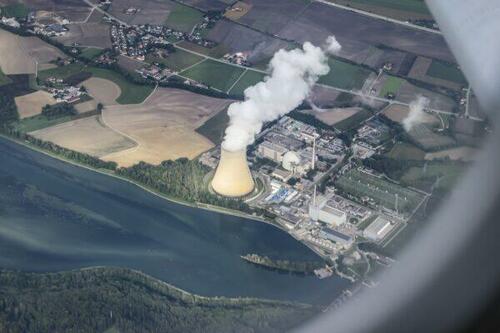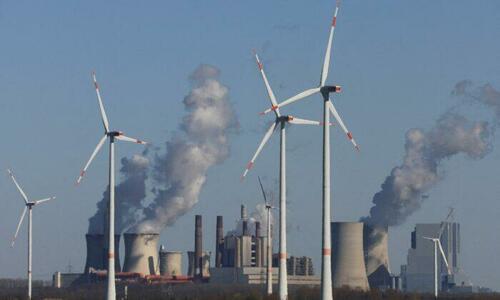
Authored by Bryan Jung via The Epoch Times,
Germany is returning to coal as it faces its worst energy crisis in decades, even as it officially pursues its climate change goals.
The central European nation is consuming coal at the fastest pace in almost six years, as it becomes one of the few countries to increase imports of the fuel in 2023, reported Bloomberg.
One of the oldest and cheapest sources of energy, coal, has made a comeback after soaring energy costs worldwide, particularly in Europe, which is suffering from an acute economic crisis due to declining relations with Moscow.
A few coal plants were temporarily reactivated in Europe this year because of gas shortages after being closed or mothballed to weather the current energy crisis.
Global coal consumption hit a record high of over 8 billion tonnes this year, said the International Energy Agency (IEA).
Despite the spike in coal use in the European Union, carbon emissions for November were at their lowest in 30 years, according to the Centre for Research on Energy and Clean Air.
Germany Faces Severe Energy Crisis
Germany’s Green Party and the coalition government in Berlin, which it is part of, planned on phasing out coal by 2038 but is now pushing for an earlier target of 2030.
However, the Russian war with Ukraine and the ensuing loss of the majority of Europe’s natural gas supplies have led to a revival of the venerable fossil fuel.
Europe’s largest economy is attempting to balance the short-term priority of boosting its energy security while keeping with its long-term “net-zero emissions” goals.
Steam gushes out of the cooling tower of the Isar 2 nuclear power plant in Essenbach, Germany, on Sept. 13, 2022. (Jan Woitas/dpa via AP)
Approximately 36.3 percent of the electricity on the German power grid between July and September of this year came from coal-fired power plants, up from 31.9 percent in the third quarter of 2021, according to German statistics office Destatis.
The German statistics agency reported that coal-to-power generation output rose by 13.3 percent year over year to 42.9 TWh in the same period, while overall German power output, at 118.1 TWh during that time by 0.5 percent.
The IEA said that Germany saw the highest rise in coal consumption, with a rise of 19 percent, or 26 million tonnes, over last year.
Meanwhile, energy from natural gas rose slightly in Germany, despite the higher prices, while wind and hydro output were low.
Berlin Delays Shutting Down Nuclear And Coal
Domestic nuclear output fell during the third quarter after Germany reduced the number of its active reactors to three from six a year earlier due to Berlin’s decision to phase out the technology following the Fukushima disaster.
Back in October, Chancellor Olaf Scholz overruled his coalition by keeping the three remaining nuclear plants online until, at the latest, mid-April 2023.
“Only in Germany, with 10 gigawatts, is the reversal at a significant scale. This has increased coal power generation in the European Union, which is expected to remain at these higher levels for some time,” according to the IEA’s annual coal market report on Dec. 16.
Due to maintenance problems at French nuclear power plants, Germany has become, for the first time this year, a net exporter of electricity to France, said Destatis.
Nuclear reactor capacity in France is now at about 68 percent, from 50 percent last month, according to Bloomberg.
The IEA said that as French nuclear output recovers and electrical production from renewable energy in Germany increases, the country would likely return to being a net energy importer within a few years.
However, the German government had issued a waiver to keep open 1.6 GW of lignite-fired power plants through March 2024, instead of closing them by the end of 2022 as planned, Reuters reported.
The decommissioning of 2.6 GW of hard coal and 1.2 GW of lignite power plants in Germany have now been postponed.
Berlin has also created a “gas replacement reserve” with a total capacity of 11.6 GW, including 1.9 GW of lignite and 4.3 GW of hard coal power plants which will remain online until 2024, according to the IEA report.
“The coal phase-out ideally by 2030 is not in question,” a spokeswoman for the German Economy Ministry said in a statement to Bloomberg.
“Against the backdrop of the crisis situation, the most important thing is that we have apparently succeeded in consuming significantly less energy in 2022, especially natural gas.”
Authored by Bryan Jung via The Epoch Times,
Germany is returning to coal as it faces its worst energy crisis in decades, even as it officially pursues its climate change goals.
The central European nation is consuming coal at the fastest pace in almost six years, as it becomes one of the few countries to increase imports of the fuel in 2023, reported Bloomberg.
One of the oldest and cheapest sources of energy, coal, has made a comeback after soaring energy costs worldwide, particularly in Europe, which is suffering from an acute economic crisis due to declining relations with Moscow.
A few coal plants were temporarily reactivated in Europe this year because of gas shortages after being closed or mothballed to weather the current energy crisis.
Global coal consumption hit a record high of over 8 billion tonnes this year, said the International Energy Agency (IEA).
Despite the spike in coal use in the European Union, carbon emissions for November were at their lowest in 30 years, according to the Centre for Research on Energy and Clean Air.
Germany Faces Severe Energy Crisis
Germany’s Green Party and the coalition government in Berlin, which it is part of, planned on phasing out coal by 2038 but is now pushing for an earlier target of 2030.
However, the Russian war with Ukraine and the ensuing loss of the majority of Europe’s natural gas supplies have led to a revival of the venerable fossil fuel.
Europe’s largest economy is attempting to balance the short-term priority of boosting its energy security while keeping with its long-term “net-zero emissions” goals.
Steam gushes out of the cooling tower of the Isar 2 nuclear power plant in Essenbach, Germany, on Sept. 13, 2022. (Jan Woitas/dpa via AP)
Approximately 36.3 percent of the electricity on the German power grid between July and September of this year came from coal-fired power plants, up from 31.9 percent in the third quarter of 2021, according to German statistics office Destatis.
The German statistics agency reported that coal-to-power generation output rose by 13.3 percent year over year to 42.9 TWh in the same period, while overall German power output, at 118.1 TWh during that time by 0.5 percent.
The IEA said that Germany saw the highest rise in coal consumption, with a rise of 19 percent, or 26 million tonnes, over last year.
Meanwhile, energy from natural gas rose slightly in Germany, despite the higher prices, while wind and hydro output were low.
Berlin Delays Shutting Down Nuclear And Coal
Domestic nuclear output fell during the third quarter after Germany reduced the number of its active reactors to three from six a year earlier due to Berlin’s decision to phase out the technology following the Fukushima disaster.
Back in October, Chancellor Olaf Scholz overruled his coalition by keeping the three remaining nuclear plants online until, at the latest, mid-April 2023.
“Only in Germany, with 10 gigawatts, is the reversal at a significant scale. This has increased coal power generation in the European Union, which is expected to remain at these higher levels for some time,” according to the IEA’s annual coal market report on Dec. 16.
Due to maintenance problems at French nuclear power plants, Germany has become, for the first time this year, a net exporter of electricity to France, said Destatis.
Nuclear reactor capacity in France is now at about 68 percent, from 50 percent last month, according to Bloomberg.
The IEA said that as French nuclear output recovers and electrical production from renewable energy in Germany increases, the country would likely return to being a net energy importer within a few years.
However, the German government had issued a waiver to keep open 1.6 GW of lignite-fired power plants through March 2024, instead of closing them by the end of 2022 as planned, Reuters reported.
The decommissioning of 2.6 GW of hard coal and 1.2 GW of lignite power plants in Germany have now been postponed.
Berlin has also created a “gas replacement reserve” with a total capacity of 11.6 GW, including 1.9 GW of lignite and 4.3 GW of hard coal power plants which will remain online until 2024, according to the IEA report.
“The coal phase-out ideally by 2030 is not in question,” a spokeswoman for the German Economy Ministry said in a statement to Bloomberg.
“Against the backdrop of the crisis situation, the most important thing is that we have apparently succeeded in consuming significantly less energy in 2022, especially natural gas.”
Loading…







